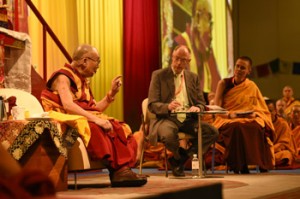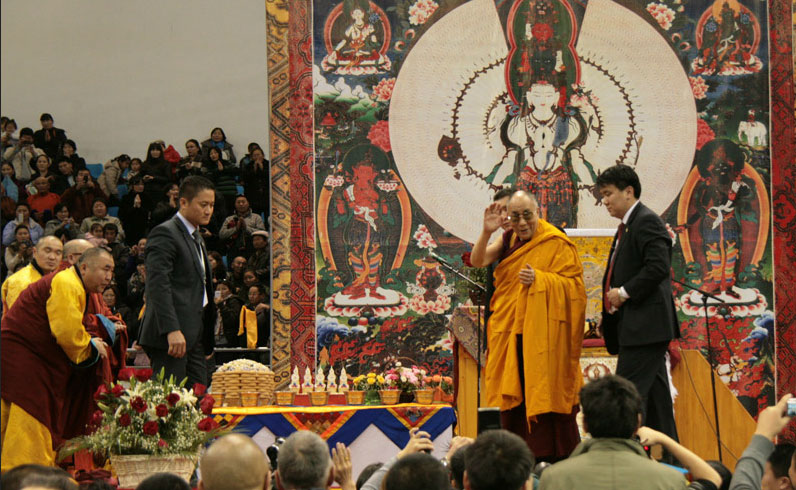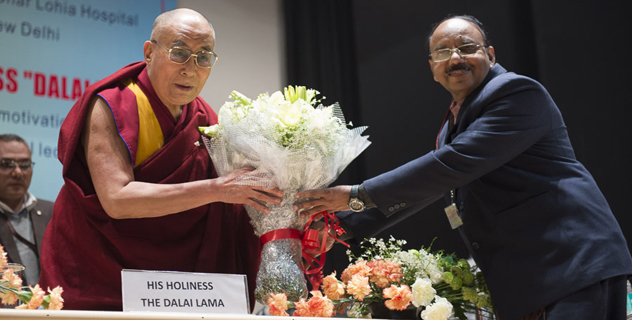Explaining ‘The Guide to the Bodhisattva’s Way of Life’
[dalailama.com] Hamburg, Germany, 24 August 2014 – Emerging from his hotel into the sunlight falling through the trees, His Holiness the Dalai Lama took time to greet Tibetans and other well-wishers who had gathered to express their respect and support.
Reaching the stage of the Congress Centre Hamburg, his first act was to salute a 104 year old woman who had been brought to meet him. The audience was moved as a contented smile lit up the face of the almost motionless old lady in her wheelchair.

“Today there’ll be an explanation of the Buddhadharma according to the Nalanda tradition,” His Holiness began. “The Tibetan Buddhist tradition originated with the invitation to Tibet in the 8th century of the then leading scholar of Nalanda University, Shantarakshita, by the Tibetan Emperor, Trisong Detsen. Buddhism had been introduced to China some four centuries earlier, a tradition also linked to Nalanda by Hsuan Tsang who studied there with Dharmapala. The prevailing philosophical views belonged to the Mind Only and Middle Way Schools and whereas China predominantly followed Mind Only, Shantarakshita established the Middle Way view, the tradition following Nagarjuna, in Tibet.”
Describing himself as a minor student to the Nalanda tradition, His Holiness said he was happy to have the opportunity to discuss Shantideva’s ‘Guide to the Bodhisattva’s Way of Life’ and Thogme Sangpo’s ‘37 Practices of a Bodhisattva’. He pointed out the difficulty of explaining everything in four sessions, but encouraged his listeners to take the book away with them to read and study themselves.
He explained that Shantideva, who lived in the 8th century CE, composed two texts the ‘Compendium of Training’ and ‘Guide to the Bodhisattva’s Way of Life’, which complement each other. Shantideva followed the Consequentialist Middle Way view propounded by Chandrakirti that asserts that while things have no objective existence they nevertheless exist conventionally.

His Holiness paused to commend Kelsang Wangmo, a German nun assisting his German translator, Christof Spitz, as the first woman to be granted a Geshe-ma degree. Turning to the text, he read its title in Sanskrit and Tibetan, initiating a complex discussion of the word ‘bodhi’ or ‘chang-chub’, which is translated as enlightenment, but specifically refers to purifying or clearing away ignorance and to knowing. It implies that Buddhahood is attained by overcoming ignorance, clearing away the obstructions to knowledge by developing an understanding of emptiness, supported by the skilful means of bodhichitta. The Buddha made it clear that this is something we have to do for ourselves by following the path he revealed.
“Buddhas do not wash unwholesome deeds away with water,
Nor do they remove the sufferings of beings with their hands,
Neither do they transplant their own realization into others.
Teaching the truth of suchness they liberate (beings).”
His Holiness turned to Chapter Nine of the ‘Guide’, the wisdom chapter, saying that all the Buddha’s 84,000 teachings were taught in order that people could develop an understanding of reality such that they could purify their minds of all defilements. To overcome ignorance that is the basis of disturbing emotions like attachment we need to know things as they really are. His Holiness recalled the advice of American psychotherapist Aaron Beck that when we are angry or attached to something, about 90% of our anger or attachment is mental projection, a view that accords with Nagarjuna’s. We get caught up with how things appear to us instead of seeing them as they really are.
“Amongst human beings,” His Holiness remarked, “there are those who use their minds to investigate reality, who the text refers to as yogis, and those who simply follow their day to day lives. We could say that today, scientists are like yogis in that they attempt to see things as they really are. But even among yogis there are differences of understanding.”
His Holiness further commented that the different views of reality explained in Chapter Nine of the ‘Guide’ are complicated, but that analysing them is very helpful. The aim of such analysis is to uproot ignorance that is at the root of all disturbing emotions. He pointed out that it wasn’t until he was about 15 years old that he began to really take an interest in emptiness. In his 30s he really tried to study and put into practice what he understood.
“Only when you develop some understanding of emptiness do you become aware of the actual possibility of attaining Buddhahood. Although we all recite the verse for taking refuge in the Buddha, Dharma and Sangha and developing the awakening mind of bodhichitta, we generally don’t understand what it means. If you think closely about it, you can understand the process of transforming the mind into the mind of enlightenment.”
As the session broke for lunch, His Holiness advised:
“Ask yourself, who is this ‘I’ who eats lunch? Where is it? The ‘I’ is not the body and it isn’t the mind either. Where is it? Who is this hungry person? That way we can make lunch useful too.”
Meeting with members of the Tibet Centre Hamburg afterwards, His Holiness encouraged them to continue to make it a centre of learning, not only dedicated to Buddhism but to a wider knowledge of the workings of the mind. He mentioned the recent publication of a book in Tibetan containing science extracted from the Kangyur and Tengyur. He said that the English translation may be complete by the end of the year and requested the Centre to become involved in translating it into German. He also spoke to about 650 Tibetans resident in Europe. He noted that as refugees they have been in exile for 55 years. He praised the people in Tibet, whose spirit has remained unflinching despite the change of generations over the same period. He encouraged them to be careful to maintain Tibetans’ good reputation for gentleness and honesty.
Back in the Congress Centre hall His Holiness received and answered several questions from the audience, among them a request for guidance on choosing a spiritual teacher. His advice was to consult the list of qualifications for such a teacher described in the scriptures and to examine the prospective teacher to see whether he or she fulfilled them, a process that could even take years. He recommended making a commitment to a teacher only when you feel confident about him or her.
Returning to his survey of Chapter Nine of the ‘Guide’, he explained that ignorance is eliminated by the wisdom understanding emptiness because ignorance and wisdom, like light and dark, cannot coexist together. And ignorance is weaker not being supported by knowledge. His Holiness said:
“The ninth chapter is very important because it is on the basis of a genuine insight into emptiness that we develop a sense that liberation from suffering is possible and that the disturbing emotions can be eliminated. From that understanding arises the desire to achieve such liberation. Then, considering the predicament of sentient beings we develop the awakening mind of bodhichitta and the wish to serve them.”
He went on to stress that Buddhists should aspire to be 21st century Buddhists, understanding what the Buddha is and that the Dharma is the true path and true cessation.
Looking back to Chapter One of the ‘Guide’ he said it explains the awakening mind of bodhichitta, the ultimate wish to help other beings. It involves an aspiration to achieve enlightenment that is not just wishful thinking but is based on knowing that being of real help to other beings is possible.
His Holiness brought the day’s teachings to an end saying he would go through the process of formally generating bodhichitta tomorrow. He joked that going through the text this way is a bit like an elderly person’s approach to food, picking only those bits that are easy to chew. He mentioned the short and long-term advantages of bodhichitta, including freedom from lower rebirth, achieving higher rebirth and ultimately enlightenment. But, he said, the corresponding process of transforming yourself takes time. He remembered when he used to garden in Dharamsala and because he wanted to see the flowers bloom soon he tried to encourage the process and in doing so damaged the seeds. He concluded:
“We need to give growth time.”



